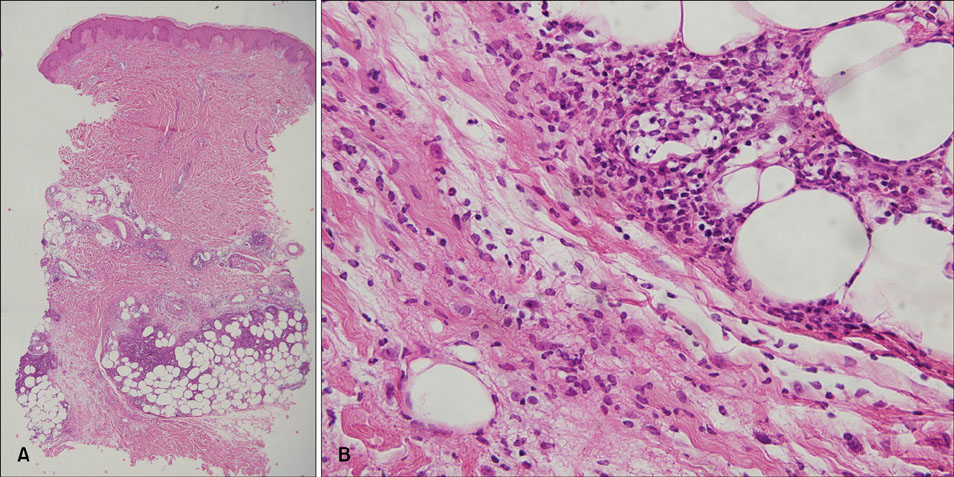Ann Dermatol.
2011 Aug;23(3):362-364. 10.5021/ad.2011.23.3.362.
A Case of Assisted Reproductive Therapy-induced Erythema Nodosum
- Affiliations
-
- 1Department of Dermatology, Seoul National University Boramae Hospital, Seoul, Korea. sycho@snu.ac.kr
- KMID: 2171930
- DOI: http://doi.org/10.5021/ad.2011.23.3.362
Abstract
- Erythema nodosum is a common variant of panniculitis. It is characterized by tender erythematous nodule and plaque on the anterior aspect of the leg. The etiology is not fully understood. It may be associated with a variety of disorders, including infection, medication, autoimmune disorders, pregnancy, and malignancy. A 33-year-old Korean woman presented with 1 week history of painful erythematous plaques on both knees. She was 7 weeks pregnant with assisted reproductive therapy, and had been maintained on daily intramuscular progesterone injection for 4 weeks. Histological examination of the lesions revealed septal panniculitis without vasculitis. Two days after discontinuing progesterone injection, the symptoms and lesions started to resolve. Herein we present a case of erythema nodosum caused by progesterone injection for endometrial preparation.
MeSH Terms
Figure
Reference
-
1. Psychos DN, Voulgari PV, Skopouli FN, Drosos AA, Moutsopoulos HM. Erythema nodosum: the underlying conditions. Clin Rheumatol. 2000. 19:212–216.
Article2. Requena L, Yus ES. Erythema nodosum. Dermatol Clin. 2008. 26:425–438. v
Article3. Foldes EG. Pharmaceutical effect of contraceptive pills on the skin. Int J Clin Pharmacol Ther Toxicol. 1988. 26:356–359.4. Requena L, Requena C. Erythema nodosum. Dermatol Online J. 2002. 8:4.
Article5. Yang SG, Han KH, Cho KH, Lee AY. Development of erythema nodosum in the course of oestrogen replacement therapy. Br J Dermatol. 1997. 137:319–320.6. Jhaveri K, Halperin P, Shin SJ, Vahdat L. Erythema nodosum secondary to aromatase inhibitor use in breast cancer patients: case reports and review of the literature. Breast Cancer Res Treat. 2007. 106:315–318.
Article7. Bombardieri S, Munno OD, Di Punzio C, Pasero G. Erythema nodosum associated with pregnancy and oral contraceptives. Br Med J. 1977. 1:1509–1510.
Article8. Im S, Lee ES, Kim W, Song J, Kim J, Lee M, et al. Expression of progesterone receptor in human keratinocytes. J Korean Med Sci. 2000. 15:647–654.
Article9. Young SL, Lessey BA. Progesterone function in human endometrium: clinical perspectives. Semin Reprod Med. 2010. 28:5–16.
Article10. Glujovsky D, Pesce R, Fiszbajn G, Sueldo C, Hart RJ, Ciapponi A. Endometrial preparation for women undergoing embryo transfer with frozen embryos or embryos derived from donor oocytes. Cochrane Database Syst Rev. 2010. CD006359.
Article
- Full Text Links
- Actions
-
Cited
- CITED
-
- Close
- Share
- Similar articles
-
- The clinical and histopatholgical study of erythema induratum and erythema nodosum
- A Case of Erythema Nodosum Migrans
- Erythema Nodosum Probably Induced by Kerion Celsi
- Erythema Nodosum Associated with Chronic Myelogenous Leukemia
- Unusual Hypertrichosis Development on the Skin Involving Erythema Nodosum Migrans



